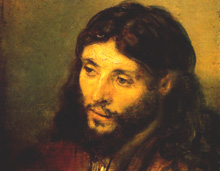Vayeitzei: Jacob, Rembrandt, and the Rolling Stones

Genesis 28:10–32:3
As Jacob prepared to bed down for the night at Beth El, he selected "among the rocks of the place" (me'avnei ha-makom; Genesis 28:11) to set by his head. He awoke in the morning having dreamt of a ladder reaching heavenwards and angels ascending and descending it, which the Sages took to represent the rise and fall of the four great kingdoms of history to which the Jews were successively subjugated. Jacob then took "the stone (ha-even) . . . and set it as a monument” (28:18). According to Rashi (1040–1105), Jacob initially selected several stones, which, arguing among themselves over the honor to prop up the patriarch’s head, were miraculously fused together overnight. His grandson Rashbam (1089–1158), however, maintains that the fact that there was but one stone when Jacob awoke is proof positive that there was only one when he went to sleep.
When Jacob subsequently arrives at Haran, he discovers that the local well is covered by "the stone" (ha-even; 28:2), which he proceeds to roll off—singlehandedly—in an apparent attempt to impress Rachel. According to talmudic legend (aggadah), Jacob, at this juncture, is 77 years old—an advanced age at which to be attempting carnival feats just to impress a comely maiden. What if he had failed? Could it be that Jacob's supreme confidence in his ability to maneuver "the stone" was due to his recognizing it as "the stone" he had previously manipulated into a monument? And if so, how had it gotten from Beth El to Haran? It must have rolled there.
While the insinuation of a "rolling stone" into the Bible seems, at first glance, preposterous, one midrash has the stone literally roll (ve-nitgalgelah ha-even) to a precise location on Mount Moriah, where it became imbedded in the ground. It was then transformed into the even ha-sh'tiyah, the Foundation Stone, above which the Holy of Holies of the Temple would later rest. As such, it would come to be known as the "omphalos," or navel of the world; the point from which everything of consequence emanates.
"The stone" reappears, however, in later biblical episodes and eventually becomes a motif in the collaborative work of two seminal figures of the 17th century.
Menasseh ben Israel (1604–1657) was born to a family of conversos that had fled Portugal on account of the Inquisition. In 1610, they moved to Amsterdam, where Menasseh was recognized as a prodigy. He founded the first Hebrew press in Holland and became an author and editor of note. Among his many self-published works was Mikveh Israel (The Hope of Israel, 1655), which was instrumental in persuading Oliver Cromwell to readmit Jews to England.
A firm believer in the impending messianic age, he wrote several treatises on this theme. Among them was Piedro Glorioso o de la Estatua de Nebuchadnezzar (The Glorious Stone of Nebuchadnezzar's Statue; Amsterdam, 1657). The book, which describes four messianic biblical scenes illustrating the redundancy of "the stone," was accompanied by four etchings prepared by Menasseh's friend, Rembrandt.
- In the first figure, representing Jacob's dream, "the stone" cushions Jacob's head as he rests midway along the ladder, rather than at its feet. This is intended to symbolize his location in Jerusalem, which, according to the aggadah, was situated opposite the midpoint of the ladder.
- In the second figure, David, confronting Goliath, has already released "the stone" (1 Samuel 17:49) hitting his mark, and the giant is tottering.
- The third figure (in which no stone figures explicitly) depicts the four fantastic creatures in Daniel's vision (chapter 7). God is positioned before a human character—representing the Messiah—while below him are the four beasts, led by the winged lion.
- In the final etching, we see the four-part statue of which King Nebuchadnezzar dreamed (reminiscent of Jacob's dream), which is labeled, sequentially: Babylon, Persia, Greece, and Rome-Ishmael. In this depiction, "the stone" (Daniel 2:34, representing the Messiah) has already knocked away the statue's legs, and—like Goliath—it totters.
Rembrandt lived for 25 years in Amsterdam's Jewish neighborhood and was well acquainted with a number of its residents. A portrait he drew of a scholar bent over a book (otherwise identified as "Faust in his study") may actually be of Menasseh ben Israel, who was likely the source of Rembrandt's information—and, quite possibly, his inspiration—about the Jewish Bible.
Recommended Bibliography:
- Steven Nadler: Rembrandt's Jews (Chicago, 2003)
- Franz Landsberger: Rembrandt, the Jews and the Bible (Philadelphia, 1961)
Moshe Sokolow, professor of Jewish education at the Azrieli Graduate School of Yeshiva University, is the author of Studies in the Weekly Parashah Based on the Lessons of Nehama Leibowitz (2008).
Comments are closed for this article.




